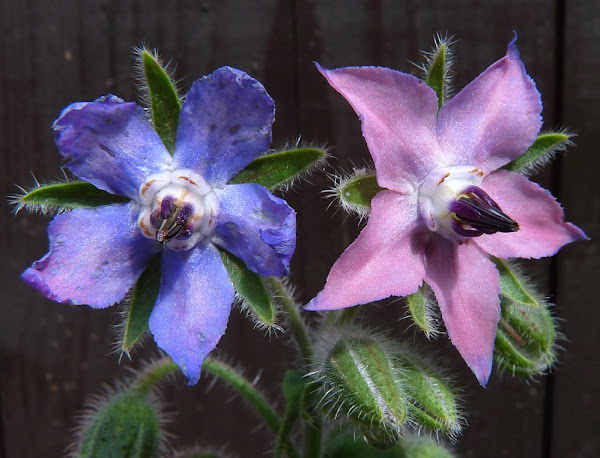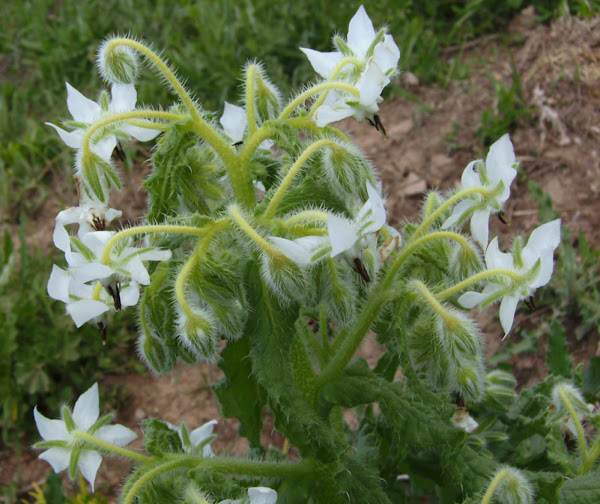Growing borage in home garden is very easy. Because it grows satisfactorily in gardens and remains in the garden from year to year by self seeding. Borage is actually grown for it’s edible leaves in some parts of Europe, and also grown commercially for ‘borage seed oil’ extracted from it’s seeds.
Borage (Borago officinalis) is an annual herb in the flowering plant family Boraginaceae, and also known as Starflower, Bee Bread, and Bee Bush. Borage is native to the Mediterranean region and has naturalized in many other locales.
Borage plants grow to a height of 2-3.3 feet, and are bristly or hairy all over the stems and leaves. Flowers are generally blue in color, although white and pink flowers are also observed sometimes. Although white flower is a different type of borage plants.
Borage was traditionally cultivated for culinary and medicinal uses. But today it is cultivated commercially mainly as an oil seed. It is either used as a fresh vegetable or a dried herb.
As a fresh vegetable, borage is often used in salads or as a garnish (it has a cucumber-like taste). Uses of borage as a fresh vegetable is popular and common in Germany, and also used in many other regions of Europe. While the borage flowers has a sweet honey-like taste and is often used for decorating desserts and cocktails.
However growing borage can provide you with cucumber-flavored leaves which you can use in may different ways. Actually, all the parts of the borage plant are flavorful and have culinary or medicinal uses (except the roots).
How to Start Growing Borage
Growing borage is very easy, and these plants require relatively less care and management. Although it is not as common as basil or thyme. It can be an unique addition for the culinary garden. Borage plants actually grow quickly as an annual but will colonize a corner of the garden by self-seeding and reappearing year after year. However, here we are describing more information about growing borage in your home garden from planting, caring to harvesting.
Borage Varieties
Borago officinalis is probably the only variety of borage. And you will find the companies are offering this variety only.

Purchase Seeds
As the borage plants are not too common, so you will probably not be able to source the seeds easily in your local market. The easy option is to order the seeds online. Today, there are many companies available with online stores. So, you can order the seeds online.
Best Time for Growing Borage
Borage is an annual plant that can be grown throughout the year. The plants have an indeterminate growth habit which may lead to prolific spreading. Flowering season of these plants is relatively long (from June to September) in the temperate climates. But the plants will bloom continuously for most of the year in the milder climates.
Preparing the Soil
The borage plants grow well in all types of soil. You just need to till the soil and add average organic matter. Ensure the soil is well drained and can retain moisture at the same time. The borage plants grows best in full sun to partial shade. But growing borage plants in full sun will give you the most flowers and the stockiest plants.
However, for preparing the soil ’till it first and then add adequate amount of organic materials into it’. Adding well-rotted aged manure or homemade organic compost will be very good.
Planting Seeds
After preparing the soil, you can sow the seeds directly into the soil. You can sow the seeds in the garden after the last frost date. Planting the seeds in rows will be good for additional caring. So mark several rows in the prepared soil to about 1 foot apart. Then plant the seeds to about 1/4 to 1/2 inch deep and 2-3 inches apart. Water the beds after planting seeds.
Caring for the Borage Plants
Growing borage plants is very easy and they require very less care, and you actually need to have a very little gardening knowledge. Although taking additional care will help to better growth of the plants. Here we are describing more about the caring steps for growing borage plants in home garden.
Fertilizing: Borage plants grow well in average soil. So, you don’t have to provide additional fertilizers for growing borage in home garden.
Watering: Keeping the soil constantly moist is required for growing Borage plants. So keep the plants well watered.
Mulching: Mulching helps to retain moisture into the soil. Use organic materials for mulching such as dry leaves, grass clippings, straw, hay or compost. Mulching will also help to prevent most of the weeds from the garden.
Thinning: Thin the seedlings to about 1 foot apart once the seedlings have reached about 6 inches height.

Pests and Diseases
Borage plants are virtually free from all types of pests and diseases. Nothing wants to get too close to the scratchy borage leaves. This is an excellent advantage of growing borage in home garden.
Harvesting
You can start to harvest the leaves and flowers as needed. Young leaves are considered good. Because the older leaves will get prickly, making harvesting anything on the plant a bit unpleasant.
Both leaves and flowers of the borage plants are edible. The flowers do add a bit of flavor and a great deal of color to salads, soups, open face sandwiches, beverages and ice cubes. And the leaves may be picked at any time and used fresh.
The dried leaves are also used and have little of the characteristic flavor. So you can use the plants after harvesting. You can also leave the flowers in the plants if you are hosting a honeybee colony in your home garden. Borage flowers produce an excellent flavored honey.
These are the common steps for growing borage organically in home garden. Hope you have enjoyed this guide! Don’t forget to share your stories. Happy gardening 🙂





